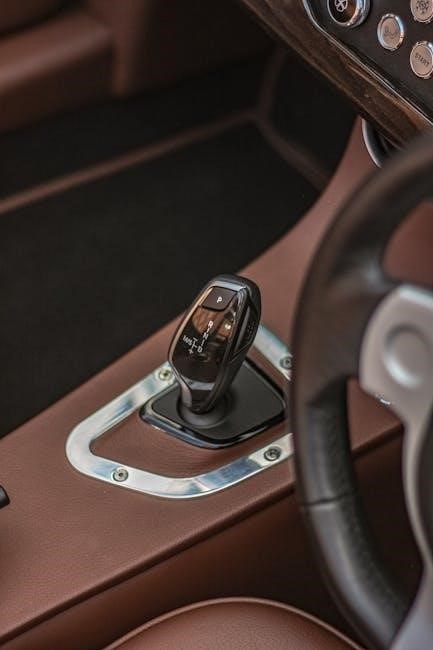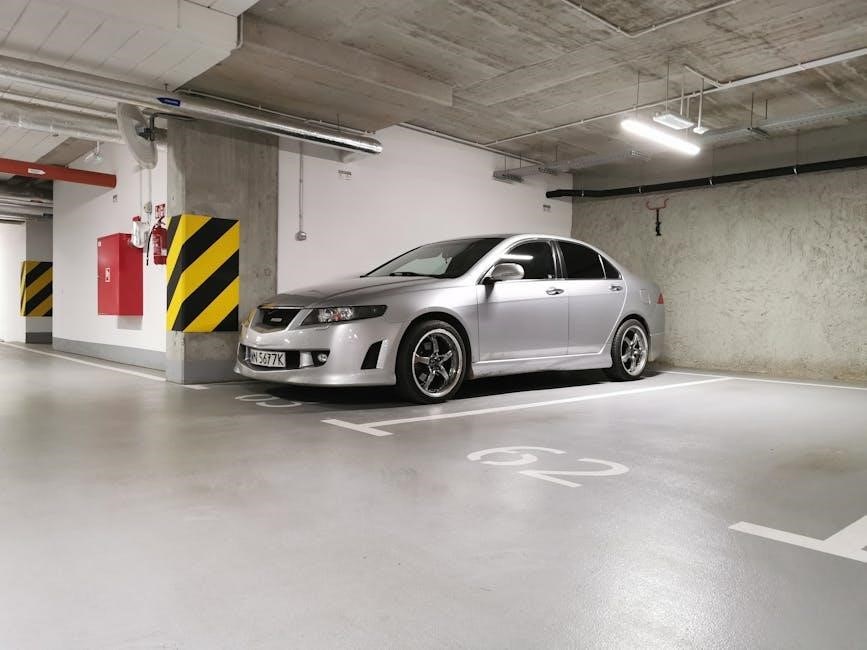The parking brake is a critical component in manual transmission vehicles, ensuring safety and control when stationary. It prevents unintentional movement, especially on inclines, by securing the rear wheels mechanically. Proper use and maintenance are vital for reliable performance and driver confidence. Understanding its operation and integration with the manual transmission system is essential for optimal functionality and vehicle stability in various driving conditions.
Overview of Parking Brake Systems
Parking brake systems are essential for securing a vehicle when stationary, particularly in manual transmission cars. These systems typically operate independently of the primary braking system, engaging the rear wheels directly. They are activated manually, often via a hand lever or pedal, ensuring the vehicle remains stationary on inclines or flat surfaces. The system consists of components like levers, cables, and calipers, which work together to lock the wheels in place. Unlike service brakes, parking brakes are designed for static situations, providing an additional layer of safety to prevent unintended movement. Regular maintenance is crucial to ensure reliability and effectiveness, as a faulty parking brake can lead to accidents or safety hazards, especially on slopes or uneven terrain.
Importance of Parking Brake in Manual Transmission Vehicles
The parking brake plays a vital role in manual transmission vehicles, ensuring safety and control when the vehicle is stationary. It prevents unintended movement, especially on inclines, by mechanically locking the rear wheels. This is crucial for preventing accidents caused by vehicles rolling away. Using the parking brake also reduces wear on the primary braking system by taking over the holding function. Additionally, it provides an extra layer of security when changing gears or starting on a slope.
Engaging the parking brake is a fundamental step in manual transmission driving. It ensures the vehicle remains stable, giving the driver confidence and control. Proper use of the parking brake is essential for safe vehicle operation, particularly in hilly or uneven terrain, where failure to engage it can lead to dangerous situations. Regular inspection and maintenance of the parking brake system are necessary to maintain its reliability and effectiveness in securing the vehicle.
Basic Components of a Parking Brake System
A parking brake system in manual transmission vehicles typically consists of several key components. These include the parking brake lever, located inside the vehicle, which actuates the system when engaged. The lever is connected to a cable system that runs to the rear brakes. The cables transmit the mechanical force from the lever to the brake shoes or pads. The brake shoes or pads are mounted on the rear wheels and press against the rotor or drum when activated, securing the vehicle. Additionally, the system includes a parking brake switch, which signals to the vehicle’s computer that the brake is engaged, often illuminating a dashboard indicator. These components work together to ensure the vehicle remains stationary when parked, providing safety and control.

How Parking Brake Works in Manual Transmission

Engaging the parking brake activates rear brakes via a mechanical system, ensuring the vehicle remains stationary. Cables apply pressure to brake shoes or pads, securing the wheels firmly.
Engagement and Disengagement Mechanisms
The parking brake engages by pulling a lever or pressing a pedal, activating cables connected to rear brakes. This mechanical system ensures reliable operation without electronic assistance. Disengagement occurs by releasing the lever or pedal, easing cable tension. Proper adjustment of cables is crucial for smooth operation. Regular maintenance ensures consistent performance, preventing issues like stuck brakes or spongy levers. Understanding these mechanisms helps drivers use the parking brake effectively, enhancing vehicle stability and safety in various conditions.
Role of Parking Brake in Securing the Vehicle
The parking brake plays a vital role in securing the vehicle by preventing unintentional movement when stationary. It mechanically locks the rear wheels, ensuring stability and safety, especially on inclines or uneven surfaces. This mechanism acts as a failsafe, complementing the manual transmission’s parking gear; By engaging the parking brake, drivers can rely on an additional layer of security, reducing the risk of accidental rolling or damage. Proper use ensures the vehicle remains stationary, even in the absence of the driver, making it an indispensable feature for safety and control in various driving conditions.
Interaction Between Parking Brake and Transmission
The parking brake and manual transmission work together to ensure vehicle stability when stationary. Engaging the parking brake mechanically locks the rear wheels, while the transmission’s gear selection (e.g., first gear or reverse) provides additional resistance against movement. This dual system enhances safety, especially on inclines, by preventing unintended rolling. The parking brake operates independently of the transmission but complements its function, ensuring the vehicle remains secure even if the transmission gear isn’t perfectly set. Proper coordination between the two systems is crucial for reliable vehicle immobilization, reinforcing driver confidence and safety in various driving conditions.

Proper Usage of Parking Brake in Manual Cars
Engage the parking brake fully on inclines or slopes to ensure stability. Always press the brake pedal firmly before activating the parking brake for added safety and control.
When to Engage the Parking Brake
The parking brake should be engaged whenever the vehicle is stationary for an extended period, especially on inclines or slopes. Always activate it after coming to a complete stop and before shifting into neutral or first gear; This ensures the vehicle remains secure and prevents rolling. Additionally, engage the parking brake even on flat surfaces to add an extra layer of safety, especially in areas with traffic or potential distractions. Consistent use helps maintain the system’s effectiveness and prevents wear on other braking components. Remember, the parking brake is a crucial secondary braking system that enhances vehicle stability when parked.
Step-by-Step Guide to Engaging the Parking Brake
Engaging the parking brake in a manual transmission vehicle is a straightforward process that ensures safety and stability. First, bring the vehicle to a complete stop using the foot brake. Next, press and hold the parking brake pedal or lever until it clicks or feels secure. Once engaged, shift the transmission into first gear or reverse to add an extra layer of security. Finally, verify that the vehicle is stable and does not roll by lightly releasing the foot brake. Always follow this sequence to ensure the parking brake holds effectively, especially on inclines or uneven surfaces. This method prevents accidental movement and enhances overall safety.
Best Practices for Parking on Inclines
When parking on inclines, it’s crucial to follow specific steps to ensure safety. On uphill slopes, turn the wheels towards the curb and engage the parking brake firmly. For downhill inclines, turn the wheels away from the curb and apply the parking brake securely. In manual transmission vehicles, shift into first gear or reverse to lock the wheels and axles, providing additional stability. Always avoid relying solely on the foot brake, especially on steep slopes. Check your surroundings to ensure the area is clear and safe. Finally, perform a quick verification by attempting to roll the vehicle slightly to confirm the parking brake holds effectively. These practices help prevent accidental movement and enhance safety on inclined surfaces.

Maintenance and Inspection of Parking Brake
Regular inspection of parking brake components ensures optimal performance. Check brake pads, cables, and levers for wear or damage. Lubricate moving parts to prevent corrosion and ensure smooth engagement. Timely repairs prevent failure and enhance safety in manual transmission vehicles.
Regular Inspection Checklist
A regular inspection checklist for the parking brake in manual transmission vehicles includes checking brake pads for wear, ensuring cables are free from corrosion or fraying, and verifying lever functionality. Proper lubrication of moving parts is essential to prevent rust and ensure smooth operation. Additionally, test the parking brake’s holding power on various inclines to confirm it secures the vehicle effectively. Addressing any issues promptly helps maintain safety and reliability, preventing costly repairs and potential failures. Regular maintenance ensures the parking brake operates efficiently, providing peace of mind during daily driving and parking situations.
Adjusting the Parking Brake for Optimal Performance
Adjusting the parking brake involves a systematic approach to ensure reliability and safety. Begin by consulting your vehicle’s manual for specific instructions, as procedures may vary. Typically, this involves loosening the parking brake cables to reset them before tightening evenly to prevent uneven braking. It’s crucial to ensure both sides are adjusted equally to maintain balanced braking. Jacking up the car and inspecting the rear brakes can provide better access and visibility. Testing the parking brake on a steep incline post-adjustment is essential to confirm it holds the vehicle securely. Special tools like wrenches or pliers may be necessary, and while assistance is helpful, the task is manageable independently with careful attention to detail. Proper adjustment ensures safety and prevents future issues, especially when parking on inclines.
Common Maintenance Mistakes to Avoid
When maintaining the parking brake system, several common mistakes should be avoided to ensure optimal performance. One of the most frequent errors is neglecting to inspect and clean the brake cables, which can lead to corrosion and reduced efficiency. Another mistake is failing to tighten the cables properly after adjustment, resulting in a loose or ineffective parking brake. Additionally, drivers often overlook the importance of regular lubrication of moving parts, which can cause stiffness and wear over time. Improper alignment of the brake shoes or drums is another oversight, leading to uneven braking. Lastly, ignoring the brake fluid level can compromise the entire braking system. Regular checks and adherence to manufacturer guidelines are essential to prevent these issues and maintain reliable functionality.

Troubleshooting Common Issues
Common issues include a stuck parking brake, failure to engage, or spongy brake levers. Check for worn components, air in the system, or damaged cables. Regular inspection and timely repairs are essential to ensure reliable operation and prevent further damage. Always consult your vehicle’s manual or a professional mechanic for persistent problems.
Diagnosing Parking Brake Failure
Diagnosing parking brake failure involves identifying symptoms like the brake not holding the vehicle on inclines or a spongy brake lever. Inspect for worn brake pads, damaged cables, or misaligned components. Check the brake fluid level and look for leaks. Test the parking brake by engaging it on a slope; if the vehicle rolls, the system is failing. Use a multimeter to test electrical connections if equipped with electronic controls. Consult a professional if issues persist after basic checks. Regular inspections can prevent critical failures and ensure safety. Always refer to your vehicle’s manual for specific diagnostic procedures.
Fixing a Stuck Parking Brake Handle
A stuck parking brake handle can be caused by corrosion, dirt, or worn-out components. To fix it, start by applying a penetrating lubricant to the handle and surrounding mechanism. Let it sit for a few minutes before gently wiggling the handle back and forth to loosen it. If the issue persists, inspect the cable or linkage for damage or rust. Clean or replace any corroded parts and apply silicone-based lubricant to ensure smooth operation. If the handle remains stuck, consult a professional mechanic to avoid further damage. Regular maintenance, such as lubricating moving parts, can prevent this issue. Always ensure the parking brake functions properly for safety.
Addressing Spongy or Loose Brake Levers
A spongy or loose brake lever indicates potential issues with the braking system. Start by checking the brake fluid level and ensuring there are no leaks, as low fluid levels can cause sponginess. Air in the brake lines is another common cause, requiring bleeding of the system. If the lever feels loose, inspect the brake cable or linkage for wear or damage. Tightening loose connections or replacing frayed cables can resolve the issue. In severe cases, the master cylinder or brake booster may need replacement. Always address this promptly, as it directly impacts braking efficiency and safety. Regular inspection of brake components ensures reliable performance and prevents further complications.

Upgrading Your Parking Brake System

Upgrading your parking brake system can enhance performance and reliability. Consider replacing components like brake pads or cables for improved responsiveness. Installing an electronic parking brake offers modern convenience, while aftermarket accessories can boost durability and control, ensuring safer and more efficient braking in manual transmission vehicles.
Benefits of Upgrading Brake Pads
Upgrading brake pads significantly enhances braking performance and safety. High-quality pads improve heat dissipation, reducing fade during prolonged use. They also provide a firmer pedal feel, allowing for better control when engaging the parking brake. Additionally, upgraded pads minimize wear on rotors and other components, extending the lifespan of your brake system. In manual transmission vehicles, this upgrade ensures the parking brake holds securely, especially on inclines, reducing the risk of unintended movement. Furthermore, modern brake materials often produce less dust, keeping wheels cleaner, and may offer quieter operation. Investing in premium brake pads is a practical step toward improving overall vehicle reliability and driver confidence.
Installing an Electronic Parking Brake
Installing an electronic parking brake (EPB) offers enhanced convenience and reliability. The process involves replacing the manual system with electronic components, including actuators and a control module. The EPB engages automatically with the push of a button, eliminating the need for a manual lever. This modernization simplifies operation and reduces mechanical complexity. The system integrates seamlessly with other vehicle technologies, such as hill assist and stability control, to provide superior braking performance. Additionally, electronic parking brakes often include features like automatic engagement and disengagement, further improving functionality. This upgrade is particularly beneficial for manual transmission vehicles, as it enhances safety and reduces driver effort, especially in urban driving conditions. Professional installation is recommended to ensure proper calibration and system integration.
Aftermarket Accessories for Enhanced Performance
Aftermarket accessories can significantly enhance the performance and functionality of your parking brake system in a manual transmission vehicle. Upgraded brake pads made from high-performance materials, such as carbon-ceramic, offer improved heat dissipation and friction, ensuring better stopping power. Stainless steel brake cables provide durability and resistance to corrosion, reducing the risk of mechanical failure. Additionally, aftermarket electronic assist systems can be integrated to automate the parking brake engagement, offering convenience and reliability. Custom-designed brake levers or handles can also improve ergonomics and driver control. These accessories not only enhance safety but also contribute to a smoother and more precise driving experience, making them a worthwhile investment for manual transmission vehicle owners seeking optimal performance.

Safety Tips and Precautions
Always engage the parking brake fully and verify its hold, especially on inclines. Regular inspections ensure reliability and prevent accidents. Avoid sudden movements when disengaging.
Ensuring Vehicle Stability on Slopes
When parking on slopes, proper use of the parking brake is crucial to prevent vehicle movement. Always stop completely before engaging the brake. Shift into first gear (or reverse for descending slopes) and turn wheels appropriately. For added safety, use wheel chocks if available. Regular inspection ensures reliable performance. Following these steps helps maintain stability and prevents accidents, especially on steep inclines. Proper techniques, as outlined in best practices, contribute to secure parking and driver confidence in various conditions.
Preventing Accidents Due to Parking Brake Failure
Preventing accidents caused by parking brake failure requires consistent maintenance and proper usage. Regular inspections of the parking brake system ensure early detection of worn or damaged components. Always engage the parking brake fully and verify its hold before exiting the vehicle. When parking on inclines, use wheel chocks for added stability. Proper gear selection in manual transmission vehicles further enhances safety. Addressing issues promptly, such as spongy brake levers or uneven brake pad wear, minimizes the risk of failure. By following these practices, drivers can significantly reduce the likelihood of accidents caused by parking brake malfunction, ensuring safer vehicle operation in all conditions.
Emergency Procedures If Parking Brake Fails
If the parking brake fails, remain calm and act quickly to ensure safety. Immediately apply the foot brake firmly to bring the vehicle to a stop. In manual transmission vehicles, downshift to a lower gear to help slow the car. Once stopped, engage the hazard lights to alert others. Use wheel chocks or other supports to stabilize the vehicle if available. Do not attempt to drive until the issue is resolved. Contact a professional mechanic or roadside assistance to assess and repair the parking brake system. Always prioritize securing the vehicle to prevent unintended movement, especially on inclines, and ensure passenger safety before exiting the car.

Comparative Analysis
Manual and electronic parking brakes differ significantly in operation, reliability, and driver control. Manual systems offer simplicity and mechanical reliability, while electronic systems provide advanced features and convenience.
Manual vs. Electronic Parking Brakes
Manual parking brakes rely on a physical lever or pedal to engage the braking mechanism, typically acting on the rear wheels through cables. This system is straightforward, durable, and less prone to electronic failures, making it a reliable choice for manual transmission vehicles.
Electronic parking brakes, on the other hand, use electronic actuators and buttons for engagement, often integrating with advanced driver-assistance systems. They offer convenience, automatic engagement, and reduced driver error, but depend on electronic components that can malfunction.
While manual systems are preferred for simplicity and mechanical reliability, electronic brakes provide modern features and ease of use, catering to different driver preferences and technological advancements in automotive engineering.
Advantages of Manual Parking Brakes in MT Cars
Manual parking brakes offer distinct advantages in manual transmission vehicles. Their simplicity and reliability make them a preferred choice for many drivers. Unlike electronic systems, manual parking brakes rely on a straightforward mechanical connection, reducing the risk of electronic failure and ensuring consistent performance.
They also provide a tangible sense of control, as drivers can directly engage the brake with a lever or pedal, fostering a stronger connection to the vehicle. Additionally, manual systems are generally more cost-effective and require less complex maintenance compared to electronic alternatives.
This simplicity also reduces the likelihood of system malfunctions, making manual parking brakes a dependable option for securing vehicles, especially in challenging conditions like steep inclines.
Future Trends in Parking Brake Technology
FUTURE TRENDS IN PARKING BRAKE TECHNOLOGY ARE EVOLVING RAPIDLY, WITH A FOCUS ON AUTOMATION AND INTEGRATED SYSTEMS. ELECTRONIC PARKING BRAKES (EPBs) ARE BECOMING INCREASINGLY POPULAR, OFFERING CONVENIENCE AND IMPROVED SAFETY.
ADVANCEMENTS LIKE AUTO-HOLD AND HILL-HOLD FUNCTIONS ARE NOW COMMON, REDUCING DRIVER EFFORT AND ENHANCING CONTROL ON SLOPED TERRAIN. ADDITIONALLY, INTEGRATION WITH OTHER VEHICLE SYSTEMS, SUCH AS STABILITY CONTROL AND AUTOMATED DRIVING FEATURES, IS EXPECTED TO IMPROVE OVERALL VEHICLE SAFETY.
MANUFACTURERS ARE ALSO EXPLORING REGENERATIVE BRAKING TECHNOLOGIES TO OPTIMIZE ENERGY USE, PARTICULARLY IN ELECTRIC AND HYBRID VEHICLES. THESE INNOVATIONS ARE SET TO TRANSFORM THE PARKING BRAKE SYSTEM, MAKING IT MORE EFFICIENT AND RELIABLE IN THE FUTURE.
The parking brake in manual transmission vehicles plays a vital role in ensuring safety and control. Proper engagement and disengagement mechanisms are essential for securing the vehicle, especially on inclines. Regular maintenance, including inspections and adjustments, is crucial for optimal performance. Understanding the interaction between the parking brake and transmission enhances overall vehicle stability. Best practices, such as engaging the brake on slopes and avoiding common mistakes, prevent accidents. Troubleshooting issues like stuck handles or spongy levers ensures reliability. Upgrading components, like brake pads or installing electronic systems, can enhance performance. Following safety tips, such as ensuring stability on slopes, prevents failures and potential accidents. By adhering to these guidelines, drivers can maintain a safe and reliable parking brake system in their manual transmission vehicles.
Recommended Tools and Resources for Further Learning
For a deeper understanding of parking brake systems in manual transmissions, utilize diagnostic tools like multimeters and pressure gauges to assess brake performance. OBD-II scanners can help identify system faults. Online resources such as repair manuals and technical guides provide detailed instructions. Websites like Autozone and O’Reilly Auto Parts offer repair guides and videos. Forums such as Reddit’s r/MechanicAdvice or automotive repair communities allow for expert advice. Manufacturer-specific resources ensure accuracy for your vehicle. These tools and resources empower you to maintain and troubleshoot your parking brake system effectively, ensuring safety and reliability on the road.